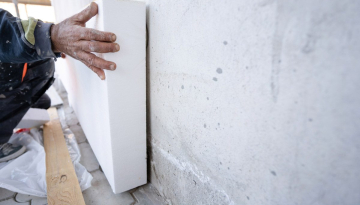Using energy efficient modern building products – such as house wrap and foam plastic insulation – helps dramatically reduce home energy needs. Improving home energy efficiency also is one of the easiest and most cost-effective ways for us to reduce greenhouse gas emissions… and to save money.
Plastic Helps Insulate & Seal the Building Envelope
Each cubic foot of outside air that enters a home via infiltration must be heated/cooled to return the house to its thermostat set point. A typical home built in 2002 to 2003 replaces roughly 55% of its air volume every hour with unconditioned outside air. A well-insulated and sealed home replaces less than 10% of its air volume per hour.
To drive down energy use in our homes, newer construction practices rely heavily on energy-saving plastic building materials that improve insulation performance (R-value) and limit unwanted airflow.
Plastic building products – spray and rigid foam insulation, house wrap, window frames, caulks/sealants and more – play crucial roles in sealing a building envelope against heating/ cooling losses, allowing us to save more energy and money and to reduce greenhouse gas emissions.
Too Much Wasted Energy
Nearly 40% of our nation’s energy is consumed in our homes and buildings. Heating and cooling account for most of the energy used in a typical U.S. home, but much of it is wasted due to outdated building practices.
Plastic Reduces Energy Use in our Homes and Buildings
By improving R-value and helping seal the building envelope, plastic building materials save more energy than many alternatives serving similar functions.
One study found that the energy saved by using plastic building and construction materials in one year is enough to meet the average annual energy needs of 4.6 million U.S. households.
Another study: If all U.S. single-family homes used plastic spray foam insulation, potential aggregate energy savings would be 648.37 billion kWh per year, which could save homeowners up to nearly $750 per year in electricity costs.
Plastic Reduces Greenhouse Gas Emissions in Our Homes and Buildings
Studies also find that plastic building materials help reduce greenhouse gas emissions from our homes and buildings. Study: Compared to common alternatives, foam plastic insulation “significantly increases the insulation R-value of walls, and therefore saves energy and reduces GHG emissions.”
Another study found that if all U.S. single-family homes used plastic spray foam insulation, the reduction in greenhouse gas emissions would be equivalent to taking nearly 40 million cars off the road each year. It also could reduce greenhouse emissions related to home heating/cooling by a whopping 40%.
Another study looked at reductions in greenhouse gas emissions when plastic “house wrap” became prevalent. Its use reduced greenhouse gas emissions up to 600+ million tons over 18 years, equivalent at the time to the vehicle combustion of 60 billion gallons of gasoline and saving consumers up to $68 billion dollars in energy costs.
Plastic Materials Work Together to Reduce Energy Use, Greenhouse Gas Emissions
Regardless of the energy source, a leaky home likely will never achieve maximum energy savings for the average homeowner. Ramping up a home’s energy efficiency typically requires a combination of plastic building products.
Foam insulation’s high R-value combined with house wrap and insulated windows and leak filling caulks/sealants and other materials work together to create a system that helps seal the building envelope. (Some products such as spray foam can both insulate and seal homes.)
In other words, by combining multiple modern plastic building products, homeowners and builders can dramatically reduce the amount of energy needed to power a home, in both net zero energy and conventional homes. Plus drive down energy costs and greenhouse gas emissions.
And these energy-saving plastic products are readily available today.
What We're Doing
Progress in Action
Find out how we are changing business models to embrace circularity.
Fact Sheets
Explore fact sheets on how durable building solutions are helping to make sustainable change.


